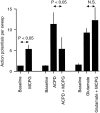Effects of the metabotropic glutamate receptor antagonist MCPG on phosphoinositide turnover and synaptic plasticity in visual cortex
- PMID: 9412480
- PMCID: PMC6793393
- DOI: 10.1523/JNEUROSCI.18-01-00001.1998
Effects of the metabotropic glutamate receptor antagonist MCPG on phosphoinositide turnover and synaptic plasticity in visual cortex
Abstract
The neurotransmitter glutamate, in addition to activating ligand-gated ion channels, also stimulates phosphoinositide (PI) hydrolysis in neurons by activating a group of G-protein-coupled metabotropic glutamate receptors (mGluRs). A role for mGluRs in synaptic plasticity originally was hypothesized based on the observation that the developmental decline in glutamate-stimulated PI turnover is well correlated with the decline in experience-dependent synaptic plasticity in visual cortex. Over the past few years, the compound alpha-methyl-4-carboxyphenylglycine (MCPG) has been widely used to test the role of PI-coupled mGluRs in a number of types of synaptic plasticity, including long-term potentiation (LTP), long-term depression (LTD), ocular dominance plasticity in visual cortex, and the neural plasticity underlying learning and memory. The conclusions of most of these studies were based on the assumption that MCPG blocks the actions of glutamate at PI-coupled mGluRs in the cerebral cortex. Here we show that this assumption is not valid in visual cortex. Although MCPG does antagonize the actions of the synthetic mGluR agonist 1S, 3R-aminocyclopentane-1,3-dicarboxylic acid, it fails to block PI turnover and changes in spike adaptation stimulated by glutamate, the endogenous mGluR ligand. In addition, we find that MCPG fails to block the NMDA receptor-dependent forms of LTP, LTD, and depotentiation in visual cortex.
Figures







Similar articles
-
Metabotropic glutamate receptors and visual cortical synaptic plasticity.Can J Physiol Pharmacol. 1995 Sep;73(9):1312-22. doi: 10.1139/y95-186. Can J Physiol Pharmacol. 1995. PMID: 8748981
-
Heterologous modulation of inhibitory synaptic transmission by metabotropic glutamate receptors in cultured hippocampal neurons.J Neurophysiol. 1996 Feb;75(2):885-93. doi: 10.1152/jn.1996.75.2.885. J Neurophysiol. 1996. PMID: 8714661
-
Dopamine receptors and groups I and II mGluRs cooperate for long-term depression induction in rat prefrontal cortex through converging postsynaptic activation of MAP kinases.J Neurosci. 1999 Nov 15;19(22):9788-802. doi: 10.1523/JNEUROSCI.19-22-09788.1999. J Neurosci. 1999. PMID: 10559388 Free PMC article.
-
Metabotropic glutamate receptors and striatal synaptic plasticity: implications for neurological diseases.Prog Neurobiol. 2004 Dec;74(5):271-300. doi: 10.1016/j.pneurobio.2004.09.005. Prog Neurobiol. 2004. PMID: 15582223 Review.
-
Postsynaptic Density Proteins and Their Role in the Trafficking of Group I Metabotropic Glutamate Receptors.J Membr Biol. 2024 Dec;257(5-6):257-268. doi: 10.1007/s00232-024-00326-z. Epub 2024 Oct 6. J Membr Biol. 2024. PMID: 39369356 Review.
Cited by
-
Wortmannin, an inhibitor of phosphatidylinositol kinases, blocks the MgATP-dependent recovery of Kir6.2/SUR2A channels.J Physiol. 1999 Feb 1;514 ( Pt 3)(Pt 3):655-65. doi: 10.1111/j.1469-7793.1999.655ad.x. J Physiol. 1999. PMID: 9882737 Free PMC article.
-
PHCCC, a specific enhancer of type 4 metabotropic glutamate receptors, reduces proliferation and promotes differentiation of cerebellar granule cell neuroprecursors.J Neurosci. 2004 Nov 17;24(46):10343-52. doi: 10.1523/JNEUROSCI.3229-04.2004. J Neurosci. 2004. PMID: 15548648 Free PMC article.
-
Multiple receptors coupled to phospholipase C gate long-term depression in visual cortex.J Neurosci. 2005 Dec 7;25(49):11433-43. doi: 10.1523/JNEUROSCI.4084-05.2005. J Neurosci. 2005. PMID: 16339037 Free PMC article.
-
Experience-dependent plasticity without long-term depression by type 2 metabotropic glutamate receptors in developing visual cortex.Proc Natl Acad Sci U S A. 2002 Jan 22;99(2):1041-6. doi: 10.1073/pnas.022618799. Proc Natl Acad Sci U S A. 2002. PMID: 11805343 Free PMC article.
-
Metabotropic glutamate receptor signaling is required for NMDA receptor-dependent ocular dominance plasticity and LTD in visual cortex.Proc Natl Acad Sci U S A. 2015 Oct 13;112(41):12852-7. doi: 10.1073/pnas.1512878112. Epub 2015 Sep 28. Proc Natl Acad Sci U S A. 2015. PMID: 26417096 Free PMC article.
References
-
- Abe T, Sugihara H, Nawa H, Shigemoto R, Mizuno N, Nakanishi S. Molecular characterization of a novel metabotropic glutamate receptor mGluR5 coupled to inositol phosphate/Ca2+ signal transduction. J Biol Chem. 1992;267:13361–13368. - PubMed
-
- Aizenman CD, Kirkwood A, Bear MF. Current source density analysis of evoked responses in visual cortex in vitro: implications for the regulation of long-term potentiation. Cereb Cortex. 1996;16:751–758. - PubMed
-
- Bashir ZI, Bortolotto ZA, Davies CH, Berretta N, Irving AJ, Seal AJ, Henley JM, Jane DS, Watkins JC, Collingridge GL. Induction of LTP in the hippocampus needs synaptic activation of glutamate metabotropic receptors. Nature. 1993;363:347–350. - PubMed
-
- Bashir ZI, Collingridge GL. An investigation of depotentiation of long-term potentiation in the CA1 region of the hippocampus. Exp Brain Res. 1994;100:437–443. - PubMed
MeSH terms
Substances
LinkOut - more resources
Full Text Sources
Other Literature Sources
Research Materials
Miscellaneous
